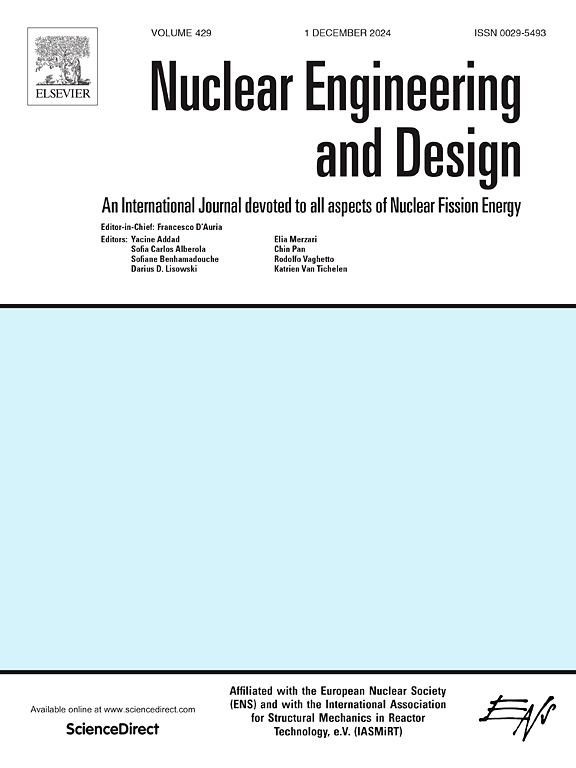Design and analysis of self-actuated shutdown system in a small lead–bismuth cooled fast reactor
IF 1.9
3区 工程技术
Q1 NUCLEAR SCIENCE & TECHNOLOGY
引用次数: 0
Abstract
The safe operation of small lead-based fast reactors (LFRs) requires ensuring that the core temperature remains within a safe range. High temperatures will intensify the corrosive effect of lead–bismuth (LBE) on structural materials, seriously affecting the core’s lifespan. By burnable poisons (BPs) design, the risk of fuel and fuel rod cladding overheating under CRW accident in the LFR-180 core can be reduced. However, the core still faces the corrosion challenges induced by elevated LBE temperatures during and following the ULOF and ULOHS scenarios. In this research, the feasibility of the application of the self-actuated shutdown system (SASS) is explored, and the function of SASS is examined under anticipated transients without scram (ATWS). The calculation results demonstrate that the SASS can effectively mitigate the core equilibrium temperature following transients, thereby significantly reducing the risk of severe corrosion of structural materials. Designed in combination with SASS and BPs, the LFR-180BP-SASS improves the safety of the core during and following ULOF, ULOHS, and CRW events.
小型铅铋冷快堆自驱动停堆系统设计与分析
小型铅基快堆(LFRs)的安全运行要求确保堆芯温度保持在安全范围内。高温会加剧铅铋对结构材料的腐蚀作用,严重影响堆芯的使用寿命。通过可燃毒物设计,可以降低CRW事故中LFR-180堆芯燃料和燃料棒包壳过热的风险。然而,在ULOF和ULOHS方案期间和之后,由于LBE温度升高,岩心仍然面临腐蚀挑战。在本研究中,探讨了自驱动停机系统(SASS)应用的可行性,并检验了SASS在无停堆预期暂态(ATWS)下的功能。计算结果表明,SASS可以有效降低瞬态后的堆芯平衡温度,从而显著降低结构材料严重腐蚀的风险。LFR-180BP-SASS结合SASS和bp设计,提高了在ULOF、ULOHS和CRW事件期间和之后的堆芯安全性。
本文章由计算机程序翻译,如有差异,请以英文原文为准。
求助全文
约1分钟内获得全文
求助全文
来源期刊

Nuclear Engineering and Design
工程技术-核科学技术
CiteScore
3.40
自引率
11.80%
发文量
377
审稿时长
5 months
期刊介绍:
Nuclear Engineering and Design covers the wide range of disciplines involved in the engineering, design, safety and construction of nuclear fission reactors. The Editors welcome papers both on applied and innovative aspects and developments in nuclear science and technology.
Fundamentals of Reactor Design include:
• Thermal-Hydraulics and Core Physics
• Safety Analysis, Risk Assessment (PSA)
• Structural and Mechanical Engineering
• Materials Science
• Fuel Behavior and Design
• Structural Plant Design
• Engineering of Reactor Components
• Experiments
Aspects beyond fundamentals of Reactor Design covered:
• Accident Mitigation Measures
• Reactor Control Systems
• Licensing Issues
• Safeguard Engineering
• Economy of Plants
• Reprocessing / Waste Disposal
• Applications of Nuclear Energy
• Maintenance
• Decommissioning
Papers on new reactor ideas and developments (Generation IV reactors) such as inherently safe modular HTRs, High Performance LWRs/HWRs and LMFBs/GFR will be considered; Actinide Burners, Accelerator Driven Systems, Energy Amplifiers and other special designs of power and research reactors and their applications are also encouraged.
 求助内容:
求助内容: 应助结果提醒方式:
应助结果提醒方式:


